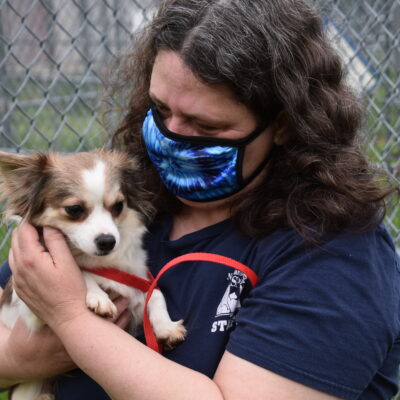Bringing home a new baby is nerve wracking enough without the concern of how your beloved dog will respond to the change. Here are some training and preparation tips to feel more confident with your dog’s behavior with the arrival of your new bundle of joy:
Put In the Training-Identify behaviors your dog performs that may be undesirable while holding your baby, bathing them, feeding them, or otherwise caring for your baby. Behaviors such as jumping up, pawing, counter-surfing, barking, and other demanding behaviors; any behaviors you would like to decrease. Remove the rewards for these undesired behavior (often your attention), and increase the rewards (attention, treats, petting, affection, praise etc.) for the behaviors you would like to see more; sitting, lying down, settling etc. Practice these behaviors in short daily training sessions anywhere in the house where you would like to see better behavior. The New Hampshire SPCA offers many training classes for all levels and ages!
Introduce Your Dog to the Smells, and Sounds of Babies-There are great CDs and also apps that have baby sounds, play these at low volumes and match these sounds with yummy treats, praise, and petting, slowly increasing the volume and vary which sounds you play. Hold a friends baby and bring the smells home for your dog to sniff and engage with, you can purchase lotions, food, and powder you will use with your new baby and let your dog be in the presence of the smells while you feed, train, and otherwise reward your dog. Once the baby is born have someone bring over an onesie the baby wore in the hospital before it comes home for your pup to sniff and familiarize with.
Prepare the Environment and Safe Zone– Well before the baby is born, prepare their room as an off-limit space for the dog, you can let the dog sniff and investigate the space before blocking them off from it, a screen door is a good option for this room, so the dog can see and smell what is going on in the room, but cannot access the space. Create a safe quiet space for your dog away from the action where they have water, a comfortable bed, and toys, this can be an area where they can retreat to on their own or an area that is confined. Your dog’s safe zone should be a positive fun place and not a punishment; spend time training and relaxing with your dog in this space, provide plenty of enrichment and reward when they choose to go here on their own.
Familiarize Your Dog to Baby Equipment-Strollers, swings, carriers, toys, cradles, etc. All the things that move and make noise; run these and move these in your dog’s presence and when your dog loses interest or relaxes near them or around them; reward. Reward for all calm behavior in the presents of new objects and equipment. If your dog seems worried about the movement, start with these items still and build up to movement at a distance from your dog, slowly desensitizing to their presence.
Carry a Fake Baby Around-This sounds silly, but getting used to maneuvering while holding a doll in your arms or a doll and a bag of rice (to replicate the weight of a baby) in a baby carrier can be very helpful to gauge and possibly modify your dog’s reaction to you having your arms full with something resembling a baby. Do not give your dog any opportunity to perform inappropriate behavior while holding the doll and reward for all calm and polite interaction.
Our trainers are here to help! In addition to training classes, we offer private consults for all your pet behavior challenges. Call us at 603-772-2921 x 112 or trainer@nhspca.org

